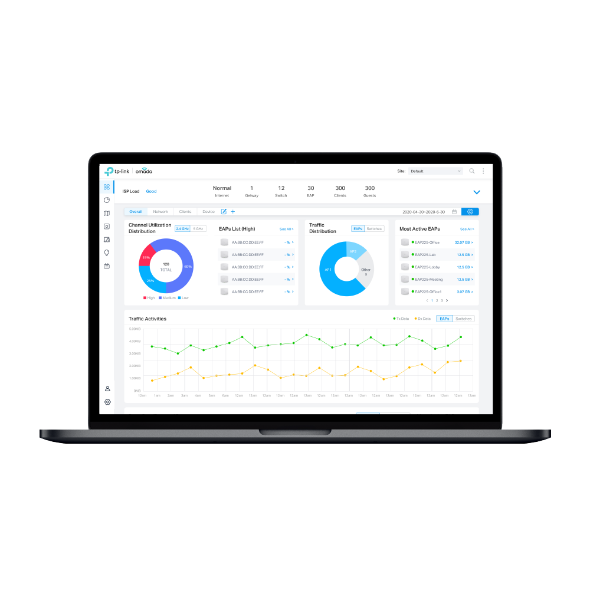How to Configure Band Steering on TP-Link Omada Controller
EAP225 V3 , EAP110-Outdoor V3 , EAP225-Wall , EAP115 V4 , OC200( V1 ) , EAP225-Outdoor , EAP225 V2 , EAP245 , EAP320 , EAP110 , EAP220 , EAP330 , EAP120 , EAP235-Wall , EAP110 V4 , EAP115 , EAP225 , EAP110-Outdoor , Omada Software Controller , EAP115-Wall
Recent updates may have expanded access to feature(s) discussed in this FAQ. Visit your product's support page, select the correct hardware version for your device, and check either the Datasheet or the firmware section for the latest improvements added to your product. Please note that product availability varies by region, and certain models may not be available in your region.
As we know, some wireless clients can only work on 2.4GHz band while dual-band wireless clients can work on both 2.4GHz and 5GHz bands. So if both single-band and dual-band clients are connected to 2.4GHz wireless network, 2.4GHz wireless network will be overloaded while 5GHz wireless network is relatively free. Band steering function can avoid this kind of waste by leading dual-band clients to connect to 5GHz wireless network with higher priority.

This document will introduce how to configure Band Steering function on Omada Controller
Based on the above topology, we can see:
- A newly-added dual-band client is trying to connect to the wireless network “TP-LINK”.
- EAP has enabled 2.4GHz and 5GHz wireless networks, and both 2.4GHz and 5GHz wireless networks share the same wireless settings including SSID & Encryption settings. (Note: Band Steering requires 2.4GHz & 5GHz wireless networks share the same wireless settings, otherwise Band Steering will not function.)
- Because most clients (single-band or dual-band) are tend to 2.4GHz wireless network which is normally more crowded than 5GHz wireless network like the topology shown above. At this time, we can enable Band Steering function to guide newly-added client to connect to 5GHz wireless network with higher priority.
Here is a configuration example of Band Steering on TP-Link EAP Controller:

Explanations about the settings and working mechanism:
- 5GHz Maximum Connection Threshold means the “maximum number of clients that can be connected to EAP’s 5GHz wireless network in priority”. In this instance, we set it as “20”, which means Band Steering function will guide the first 20 dual-band clients to connect to EAP’s 5GHz wireless network in priority. If it reaches the limitation, it means EAP already has many clients connected to its 5GHz wireless network. At this time, there may be no need to guide newly-added client to connect to EAP’s 5GHz wireless network any more.
- Difference Threshold means the “minimum client number difference between 2.4GHz and 5GHz wireless networks”. In this instance, we set it as “4”, which means if the client number difference between 2.4GHz and 5GHz wireless networks is larger than 4, 2.4GHz wireless network may be idler than 5GHz wireless network. At this time, there may be no need to guide newly-added client to connect to EAP’s 5GHz wireless network any more.
In a word, Band Steering function will always guide newly-added clients to connect to EAP’s 5GHz wireless network in priority. But if 5GHz Maximum Connection Threshold and Difference Threshold are both satisfied, there have been already many clients connected to EAP’s 5GHz wireless and 2.4GHz wireless network is idler than 5GHz wireless network. At this time, Band Steering will no more guide newly-added client to connect to EAP’s 5GHz wireless network.
Exceptions:
- If a newly-added client has failed to get connected with EAP’s 5GHz wireless network for 10 times (Maximum Fail times), EAP’s 5GHz wireless network will accept this client’s connection request even if both 5GHz Maximum Connection Threshold and Difference Threshold are satisfied.
Is this faq useful?
Your feedback helps improve this site.
What’s your concern with this article?
- Dissatisfied with product
- Too Complicated
- Confusing Title
- Does not apply to me
- Too Vague
- Other
Thank you
We appreciate your feedback.
Click here to contact TP-Link technical support.
TP-Link Community
Still need help? Search for answers, ask questions, and get help from TP-Link experts and other users around the world.
We have updated our Policies. Read Privacy Policy and Terms of Use here.
This website uses cookies to improve website navigation, analyze online activities and have the best possible user experience on our website. You can object to the use of cookies at any time. You can find more information in our privacy policy .
We have updated our Policies. Read Privacy Policy and Terms of Use here.
This website uses cookies to improve website navigation, analyze online activities and have the best possible user experience on our website. You can object to the use of cookies at any time. You can find more information in our privacy policy .
Basic Cookies
These cookies are necessary for the website to function and cannot be deactivated in your systems.
TP-Link
accepted_local_switcher, tp_privacy_base, tp_privacy_marketing, tp_smb-select-product_scence, tp_smb-select-product_scenceSimple, tp_smb-select-product_userChoice, tp_smb-select-product_userChoiceSimple, tp_smb-select-product_userInfo, tp_smb-select-product_userInfoSimple, tp_top-banner, tp_popup-bottom, tp_popup-center, tp_popup-right-middle, tp_popup-right-bottom, tp_productCategoryType
Livechat
__livechat, __lc2_cid, __lc2_cst, __lc_cid, __lc_cst, CASID
Youtube
id, VISITOR_INFO1_LIVE, LOGIN_INFO, SIDCC, SAPISID, APISID, SSID, SID, YSC, __Secure-1PSID, __Secure-1PAPISID, __Secure-1PSIDCC, __Secure-3PSID, __Secure-3PAPISID, __Secure-3PSIDCC, 1P_JAR, AEC, NID, OTZ
Analysis and Marketing Cookies
Analysis cookies enable us to analyze your activities on our website in order to improve and adapt the functionality of our website.
The marketing cookies can be set through our website by our advertising partners in order to create a profile of your interests and to show you relevant advertisements on other websites.
Google Analytics & Google Tag Manager
_gid, _ga_<container-id>, _ga, _gat_gtag_<container-id>
Google Ads & DoubleClick
test_cookie, _gcl_au
Meta Pixel
_fbp
Crazy Egg
cebsp_, _ce.s, _ce.clock_data, _ce.clock_event, cebs
lidc, AnalyticsSyncHistory, UserMatchHistory, bcookie, li_sugr, ln_or

4.0-F_normal_1593323197059j.png)
_EU_3.0_2401__normal_20240119043538b.png)